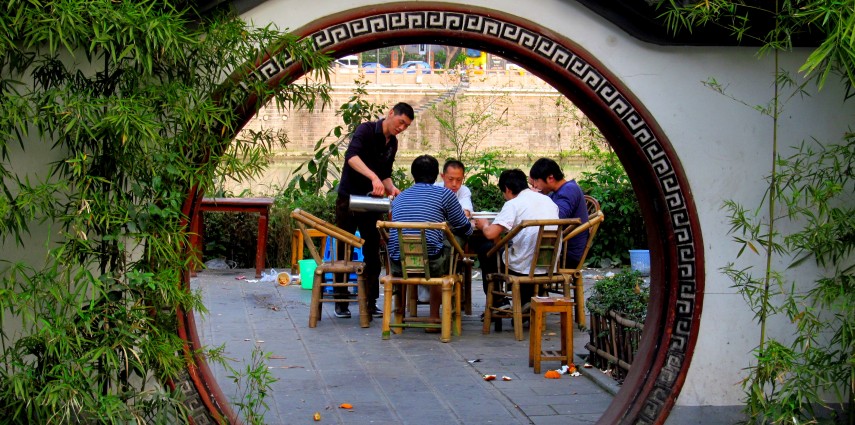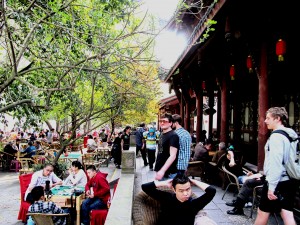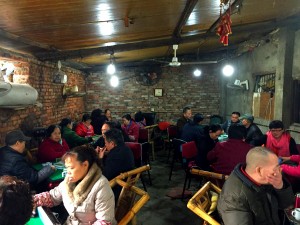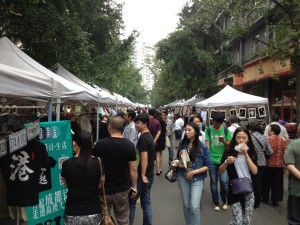Leisure in and around Chengdu, the city of leisure…
The New York Times T-Magazine recently published an article on Chengdu entitled ‘Where China Goes to Chill’ discussing the draw of the city’s relaxed, leisure-focused lifestyle. It sets the scene nicely and discusses Chengdu’s famous cuisine & tea-house culture and its current transition into a booming metropolis, but I was forced to raise an eyebrow with its list of places to check out in the city. This list presents a fairly narrow view of Chengdu through some of its most recent, upper-class and even western owned establishments.

This is how Chengdu’ers chill
While this might suit the NYT Style Magazine’s readership we don’t feel it depicts the city appropriately; it curiously presents Chengdu as an overwhelmingly bourgeois city by focusing predominantly on places accessible to only a small percentage of the population. In doing so it paints Chengdu in a greater likeness to more ‘modern and fashionable’ cities such as Shanghai – the same places from which it is trying to be differentiated. This does little to demonstrate the actual leisurely nature of Chengdu and is unbefitting of the laid-back, unpretentious attitude the city embraces. The allure of Chengdu, as it is most often articulated these days, is in a great work-life balance. This is something which acknowledges both a booming economy and a continued reverence for leisure time and the preservation of the cultural institutions, such as tea-houses, around which the city continues to meet. Teahouses and mahjong parlors, in their myriad interpretations are places that transcend class, and serve as important cultural meeting points for average people as well as the elite. Leisure should be seen here as a manifestation of the city ‘s attitudes towards finding and maintaining this balance in life and not as a privilege of the upper-classes.
And so, this is our list of things to ‘do and see now’, and one that we feel depicts the contemporary trends of the city. This is where Chengdu Goes to Chill:
NONGJIALIE or HAPPY FARMER’S INNS

A Farmer’s Inn (sometimes called a Shan Zhuang) in the countryside near Chengdu
First a quick note on Happy Farmer’s Inns (农家乐): Chengdu is the origin of these re-purposed countryside homes, and Sichuan the place where they first developed as an industry. Offering tea, food, mahjong and rooms to guests these are the result of, and physical manifestation of Chengdu’s desire to chill as much as possible. A desire which usually leads people to leave, at least, the city’s downtown. They are in essence, the very places Chengdu goes to chill.
FLOWER TOWN & XINGFU MEILIN

Locals and tourists alike flock to Xingfu Meilin, here seen relaxing on a boat in a man-made lake
A former farming community turned flower market, San Sheng Flower Town, has been reinvented as the chill-out destination spot for all locals hoping to escape the bustle and heat of the city. Located just outside the 3rd ring road this area is accessible by bike, bus, and now metro, and designed to allow people to indulge in their habits of relaxation. Farmer’s Inns galore are surrounded by lakes, greenhouses and flower peddlers. The overwhelming amount of buildings have been converted into tea-houses cum mahjong parlors, that serve up delicious countryside food. Across the road in XingFu Melin, outdoor tea and mahjong places surround a lake and provide charcoal grills alongside fridges full of meat and veggies on skewers and beer. On any sunny-day its so busy here one can hardly find a place to chill – but Chengdu people love the Renao, even when relaxing (a term that means busy, bustling & noisy but has positive connotations).
LONGQUAN MOUNTAIN

A view of Longquan’s peach blossoms from a mahjong table set in a field
The closest mountains to Chengdu lie on the edge of the fruit producing suburb of Longquan. The single road that winds its way up and back down the mountain is lined, almost exclusively, with Farmers Inns awaiting the city crowds. Again part tea-house, part mahjong parlor, part restaurant, these Inns have considerably more land surrounding them, and place tables outdoors among the blossom or fruit-bearing trees depending on the season. They also offer options not available in the city such as fruit picking, pond-fishing, and the roasting of fresh, free-range live-stock on open fires (think whole lamb roasts). The town is packed in March and April when the peach and cherry blossoms are in full force, but is popular on any sunny day throughout the year. The area also attracts young cycling an motorcycle enthusiasts who explore the smaller roads and meet at bars & outdoors clubs dotted along the hills.
- This guy is relaxed
- Tea, and a meal in the blossoms
ANCIENT TOWNS

Luodai fills with weekend chillers
Those with vehicles who have the time head out to one of the numerous preserved/reconstructed ancient towns around Chengdu (PingLe, HuangLongXi, & LuoDai are popular choices). Originally historically important places, these entire towns have been reconstructed to maintain their ancient edifices and contain an interesting combination of fancy as well as rustic tea-houses – usually lining a body of water. Despite their development into modernity, these rural places retain traditional culinary practices, making the food and in particular snacks (or small eats) a large draw. Many of the Qing or Ming style Inns here have nice rooms and are popular with families as well as the young middle-class looking to get away from the city for a weekend and enjoy the fresh air and sunshine (for which Chengdu is not famous).
PUBLIC SPACES
- No one chills harder than this guy
- A park fills with mahjong players
- A make-shift mahjong parlor
- Straight-chillin by the river
People without the time or resources to leave the city, collect in the city’s public spaces – parks, riverside walkways, street corners, or even sidewalks – where they put their chill on display. Walking around the city on any day with a hint of warmth or sunshine its impossible not to feel the ‘Chill’ of the community. It is very much this use of public spaces for all forms of relaxing that gives any visitor the immediate sense of laid-backness in the city, but it is only in realizing the ubiquity of it, how this permeates all levels of society, that one comes to understand how important this attitude is to the way of life here.
KUIXINGLOU

Massive restaurant lineups on KuiXing Lou Street
Drawing a younger and hipper crowd, this street in the original ‘Inner City’ is now lined with traditional Sichuan-style restaurants as well as bakeries, bars, coffee shops and an art gallery in addition to the gingko trees. At night people fill the streets and lines for some of the restaurants occupy whole sections of the side-walk. Once a year the entire street turns into a huge market and art & music festival.
- Snoop Doog takes a peep, on a piece of art tagged by local artist How Chill
- Market at the NuArt Alley Music Festical
ELEVENTH STREET

A classic multi-functional outdoor public/private place that still retains the feeling of Old Chengdu, 11th Street, near the Sichuan Music Conservatory and trade mark LangQiao Bridge, is a narrow dead-end alley. It is lined with small restaurants including the renowned No Name Fly Restaurant (无名苍蝇馆子), that serve up lunch to local residents on bamboo tables set in the alley. In the afternoon it converts to a tea-house/mahjong parlor and at night back into restaurants that serve hot-pot as well as crawfish in the summer time. It embraces the chill in various forms all day long – ultimately with food. But in Chengdu, as we know, the reverence for eating slow meals is very much the daily manifestation of leisure.
A huge thanks to friend and fellow Chengdu-based blogger Lunar Bella, for use of her ‘Xingfu Meilin’ picture.









